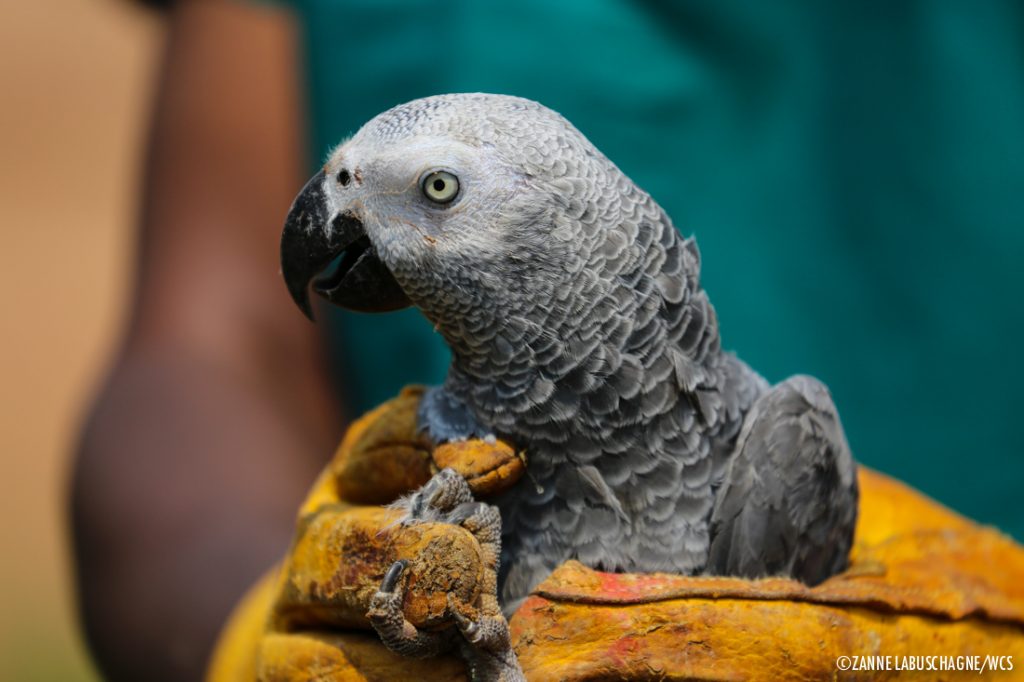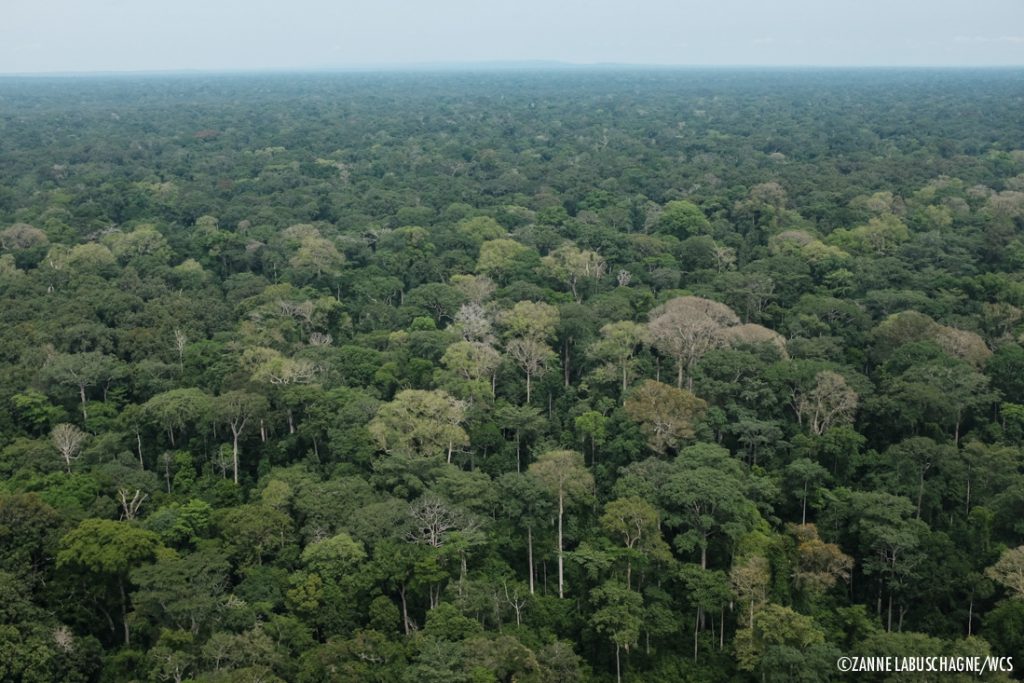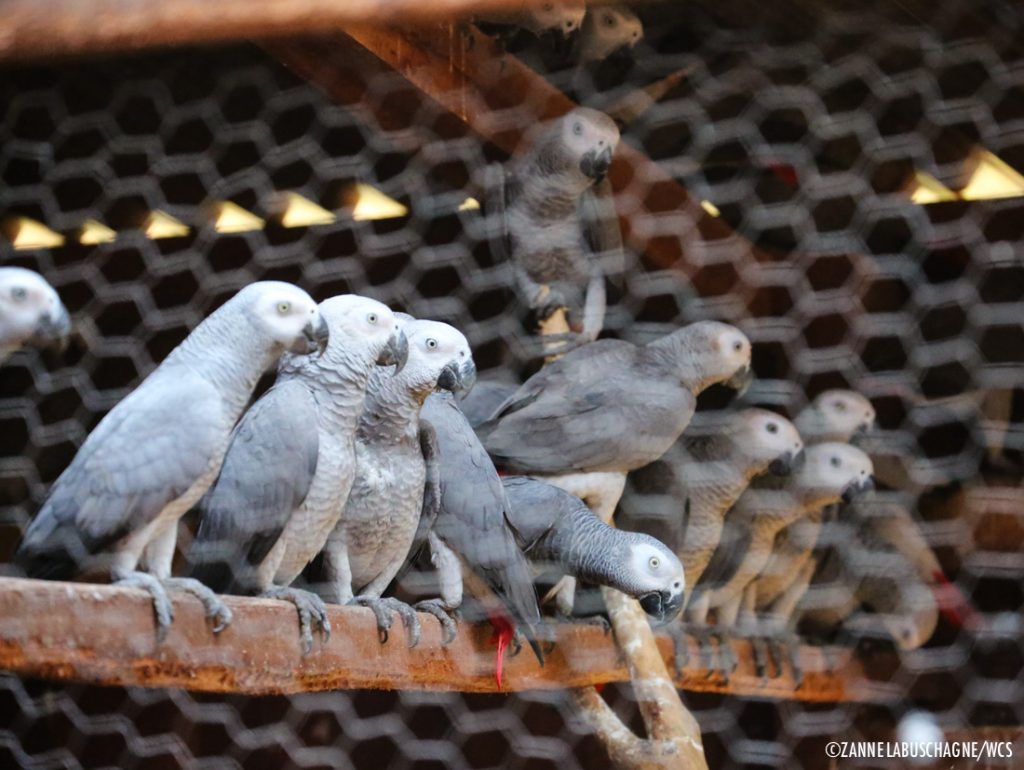Parrots in Peril
The parrots arrive in a tiny bamboo cage. As the ranger lifts them out of the poacher’s dugout canoe their angry shrieks are deafening, a far cry from the ‘music of the forest’ that African grey parrots are known for. Many individual’s wing feathers are a mangled mess from the trapping glue, and they are so closely packed that a layer of parrots are being trampled and defecated on at the bottom of the cage.
This haul of 46 contributes to a total of over 700 African grey parrots seized in and around the Nouabale-Ndoki National Park in northern Congo since the decision taken by CITES in September 2016 to up list the species to Appendix 1 – the highest level of protection regarding the regulation of international trade in endangered species. The species has also been re-categorised as Endangered on the IUCN Red List of Threatened Species. The extent of the annual harvest for international trade in parrots, in combination with the rate of ongoing habitat loss, means it is now suspected to have been undergoing rapid declines over the past three generations (47 years).

These birds are as intelligent as chimpanzees and highly social. In the wild, they mimic scores of other bird species, and even bats, but in captivity they are reduced to copying human speech, making them hugely popular around the world as pets. To supply this demand, they are being heavily hunted in west and central Africa causing their numbers in the wild to dwindle. In Ghana populations are estimated to have declined by 90-99% and in parts of the Democratic Republic of Congo, Cameroon and Republic of Congo the forests have been silenced of their calls with almost complete elimination of the species in some areas.
”I saw no parrots whatsoever on a three-hour boat ride along the river to access the Salonga National Park in DRC, compared with several groups an hour along the Sangha River to access the Nouabale-Ndoki National Park in Congo - Dr. Fiona (Boo) Maisels, Wildlife Conservation Society
The greater protection offered by CITES regarding international trade has taken time to come into effect at the national level, with the parrots still classified as partially protected in the Republic of Congo – meaning the repercussions of capture and trade in the species are far too low to deter this lucrative trade. Another factor against the parrots is a loophole in CITES that enables a member country to enter a reservation for a specific species, which enables those countries to trade outside of CITES controls. This requires at least one exporting and one importing country to enter reservations. Currently, DRC has entered this reservation as an exporting country, while, Saudia Arabia and the United Arab Emirates have entered as importing countries.
The local price that a trapper gets for a parrot in Congo has doubled since the enlistment of the species as Appendix 1 (approximately 35 USD), which seems to have caused a spike in the capture of this species by poachers. The price in the destination countries has reportedly gone through an increase of a similar magnitude. A group of investigators that work with the Nouabale-Ndoki National Park to dismantle wildlife trafficking networks in the urban areas around the Ndoki forest have identified five major transboundary parrot trafficking networks over the past six months, many of them run by foreigners (mainly DRC and Cameroon).
The pristine rainforest of the Nouabale-Ndoki National Park has long been a stronghold for many wildlife species in peril, including African Greys. Dr Fiona (Boo) Maisels of the Wildlife Conservation Society, organised parrot surveys in most of central Africa , stated that she “saw no parrots whatsoever on a three-hour boat ride along the river to access the Salonga National Park in DRC, compared with several groups an hour along the Sangha River to access the Nouabale-Ndoki National Park in Congo”. The Sangha River, which runs along Nouabale-Ndoki’s south western periphery and acts as a river highway to access the park and its precious wildlife, is now also believed to be used as the main trafficking route for parrots away from their forest home. After capture traffickers transport the parrots in small cages in dugout canoes downstream, on to the Congo river and to the trade in Kinshasa. It is estimated that only one in twenty parrots survive the journey from capture in the wild in Congo to sale on the pet market abroad.

To tackle these threats to the precious parrots of northern Congo the Nouabale-Ndoki National Park, which is managed through a public private partnership between the Congolese Government and the Wildlife Conservation Society (WCS), has stepped up efforts to dismantle these trafficking networks and stem the flow of parrots out of Congo’s forests. A strategy of increased river patrols, close collaboration with fisherman communities, investigative work to gather intelligence on trafficking networks coming in and out of the forest, coupled with the rehabilitation of seized parrots is starting to bear fruit. The latest seizure of parrots was obtained through information provided by a fisherman who had recently attended a meeting for the validation of the the fisheries mini-charter for the waterways around the Park, reinforcing the importance of community development work for the protection of the park and its wildlife.
Currently the Wildlife Conservation Society’s wildlife health program runs a rehabilitation centre that can hold 400 parrots, and a new centre will be constructed later this year at the park’s Bomassa headquarters in order to ensure more seized parrots safe recovery. It is however a slow process and unfortunately the stress these highly intelligent animals undergo is lethal for many.

At the beginning of May 35 parrots flew free from the rehabilitation centre after being nursed back to health for six months. During a check-up visit several weeks later the free flying flock was observed near the centre, visiting their pals still in recovery. The same month the Government of Congo circulated a note informing local wildlife authorities and courts of the CITES decision to offer parrots more protection and the Congolese Government’s commitment to move in the same direction. For now, there is hope in this gruelling battle to save wild African greys as some parrots return to fly free over the lush canopy of the Ndoki forest, and legal measures to increase their protection seem to be close on the horizon.
The teams in the field continue to work hard to safeguard their beloved parrots, but as long as the pet market for parrots exists, and provides such a high price for these birds, the capture and trade of African grey parrots will be very difficult to stamp out.


Debbie Goodrich
Are african greys going not just for pets but for aphrodisiacs in Asia? How can we find out? Who knows? Who follows where the birds go in the illegal trade? We need to help this species and finding out the real cause for their demise would significantly help. With Bans in Europe and America before the CITES listing, we should have seen decreases in demand, but we have not…which leads me to believe the demand is more than pets.
Nic
African Greys are being bread very successfully throughout the world. Hence there is actually no need for wild Greys. Those are much more difficult to handle, to keep and to tame. People seem to prefer the parrots coming feom breeders as most of them, even though not socialised, are mostly already tame. It is however no animal to be kept as a pet as their ethological needs are still to difficult to satisfy in captivity.
Nic
African Greys are being bread very successfully throughout the world. Hence there is actually no need for wild Greys fir commercial purposes Those wild birds are much more difficult to handle, to keep and to tame. People seem to prefer the parrots coming feom breeders as most of them, even though not socialised, are mostly already tame. It is however no animal to be kept as a pet as their ethological needs are still too difficult to satisfy in captivity.
Jean Pattison
How about CITES expedite permitting-registration and get the 50,000-80,000 aviary-bred birds in S. Africa exported out. For some reason, I think that would take great pressure off of the wild birds. The registration process is now taking almost twice as long as in the past? Since with wild African greys it is stated in most articles that only 1 in 20 survive, while some say half survive, just do the math and see how many wild greys would be saved by the 50,000-80,000 aviary-bred birds.
Jason roy
Are these African grey parrots for sale ??
Parrot Place
It is however no animal to be kept as a pet as their ethological needs are still to difficult to satisfy in captivity.People seem to prefer the parrots coming feom breeders as most of them, even though not socialised, are mostly already tame.
martin
Parrots vs Dalmatians, what will be your best decision ? Dalmatians are one of the best companion dogs in the world. Provided they’re well-socialized by the dalmatian breeders, Dalmatians should have no problem getting along with other pooches. They don’t tend to have an aggressive streak, so lots of positive experiences with other mutts early on will allow them to develop their friendly personality.They should get along fine with other pets in the house. Reputable centers will run home checks, neuter dogs and inform you of any possible health or behavioral issues following assessments and I think this is where https://dalmatianpuppyplace.com stands out from all other dalmatian breeders who have dalmatian puppies for sale.